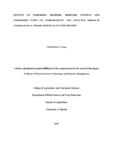| dc.description.abstract | Sorghum (Sorghum bicolor L. Moench) is among the most important cereal crop in the
world. Sorghum is a food security crop in most African and Asian countries especially in
arid and semi-arid areas where drought is persistent. However, sorghum yields are low in
most parts of Africa. One of the reasons for low production is lack of quality seeds due to
inappropriate technology including postharvest handling and processing of sorghum seeds.
The aims of this study were to evaluate the effects of endosperm type, seed moisture content
levels and threshing methods on threshability and quality parameters of the seeds. Two
varieties of sorghum were grown in two diverse locations, Kiboko and Katumani. One
variety Kari-mtama 1 has hard (vitreous) endosperm type while another variety Seredo has
soft (non-vitreous) endosperm type. After harvesting, sorghum panicles were dried in the sun
and oven. The panicles were threshed separately for each drying method at two seed
moisture levels namely 18-20% and 13-14% moisture contents (M.C). The three threshing
methods used included beating by wooden stick in tied sack, using wooden mortar and pestle
as well as threshing machine. Mechanical damage was evaluated by using tetrazolium test
while the germination percent, germination time and seedling vigour were evaluated using
paper towel method in the laboratory following ISTA rules.
The results showed that vitreous endosperm variety had significantly high percentage
threshability and significantly low mechanical damage than non-vitreous endosperm variety
under both drying methods. Also, threshing machine had significantly lower threshability
and mechanical damage compared to the other two methods. There was significant increase
in threshability and decrease in mechanical damage when the seeds were threshed at 13%-
14% moisture content. In both drying methods, the seeds that were threshed at low moisture
content (13%-14%) had significantly high germination percentage, seedlings vigour and took
xv
significantly short time to germinate compared to those which were threshed at high moisture
content (18%-20%). Similarly, seeds from panicles that were threshed using machine had
significantly higher germination percentage and seedlings vigour followed by those from
panicles that were threshed by beating with wooden stick and mortar and pestle, respectively.
Also, the seeds from panicles that were threshed using machine took significantly short time
to germinate compared to the other two threshing methods.
The results confirmed that, vitreous endosperm sorghum varieties are better for threshability
and pose breakage resistance compared to non-vitreous sorghum. However, under both
endosperm types threshing machine is the best method for threshing sorghum panicles to
obtain high quality seeds followed by beating with wooden stick. Similarly, the results
indicate that threshing should be done at low moisture content (13%-14%) for high
threshability and quality seed. There was no significant genotype by environment interaction,
implying that the results are applicable for varieties planted in different environments | en_US |



